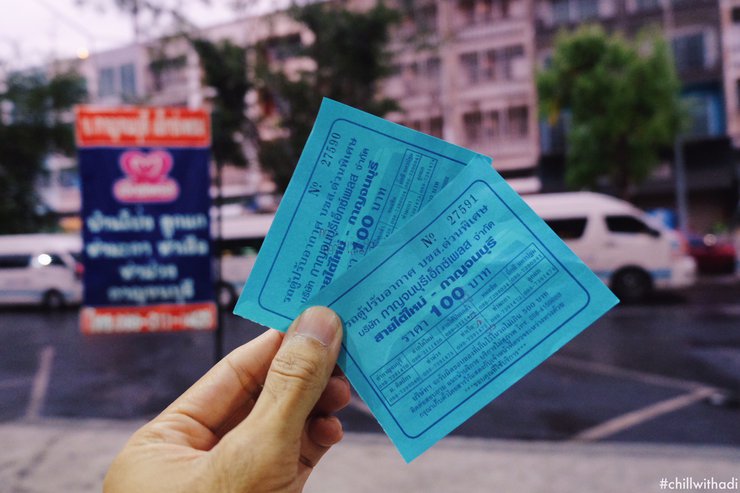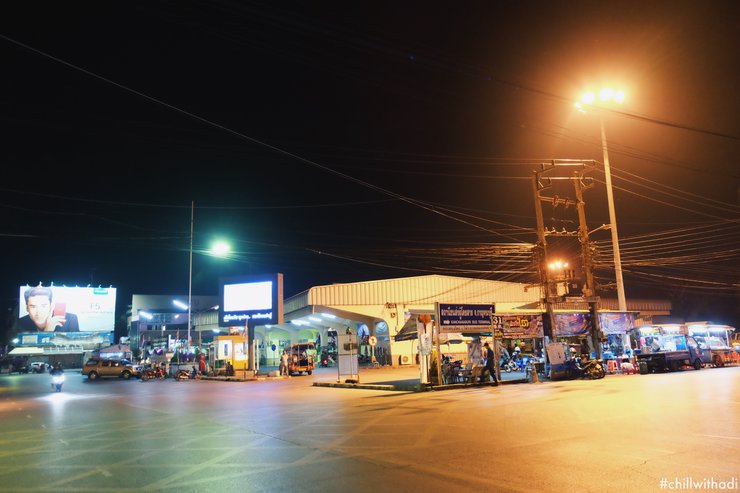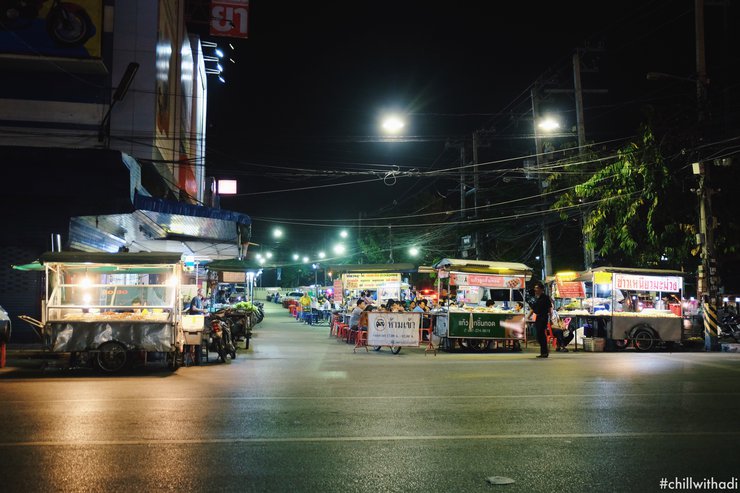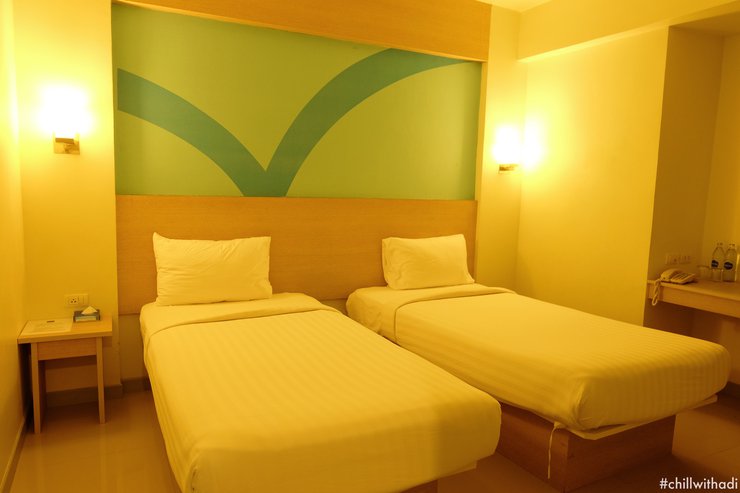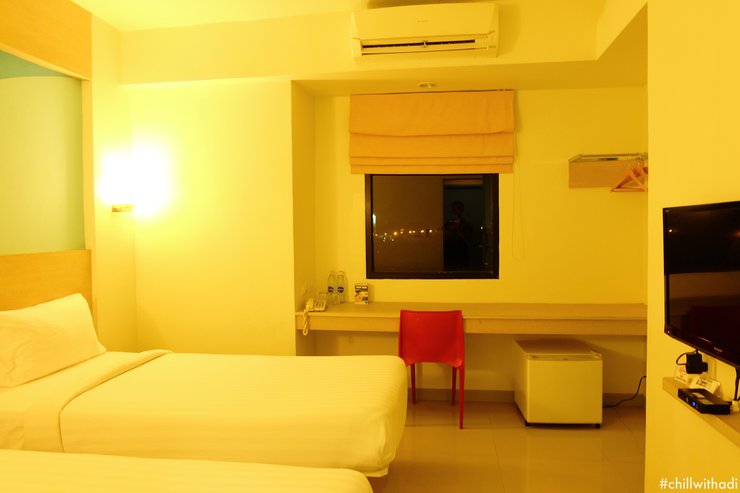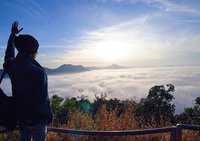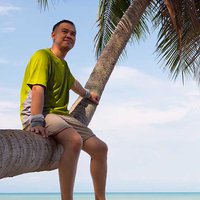Pilok-Sangkhlaburi: A Mining Village Nestled in the Valley, Experiencing the Mon Way of Life
Upon first hearing my friend mention "Pilok," I must admit that I was unfamiliar with the place. I didn't even know which part of the country it was located in. Intrigued, I did some research and discovered that it was just in Kanchanaburi, with a stunning atmosphere. Without hesitation, given its proximity, I called my travel companions, and once they confirmed their availability, we immediately started planning and booking accommodation. Since we were planning to go during a long weekend, we decided to extend our trip to Sangkhlaburi as well. Our itinerary was set: one night in Pilok and another in Sangkhlaburi. However, due to the long weekend and the limited availability of transportation to Pilok, we decided to stay in Kanchanaburi first so that we could wake up early and head to Pilok the next morning.
Day 1: Bangkok - Kanchanaburi
We set off on Friday evening because it was a long weekend and we wanted to allow some extra time. After work, we rushed to the Southern Bus Terminal, where we caught a van to Kanchanaburi. We bought tickets for 100 baht each and departed around 7 pm.

After arriving at Kanchanaburi Bus Terminal, we decided to grab a bite to eat nearby. We found a bustling night market with a wide variety of food options. After satisfying our hunger, we hopped on a motorbike taxi to our hotel, Hop Inn Kanchanaburi, which cost 30 baht per person.

The bus arrives at Kanchanaburi Bus Terminal around 9:30 PM, with a travel time of approximately 2.5 hours.

Looking for a late-night bite before checking into our booked accommodation.

The hotel we booked is Hop Inn Kanchanaburi, 550 baht per night.


Modern-style decorated room with full amenities. Take a shower and go to bed, prepare to leave early in the morning.
Day 2: Kanchanaburi - Thong Pha Phum - Pilok
We plan to wake up at 5 am and leave the hotel no later than 7 am. We will go to Kanchanaburi Bus Terminal and take a van to Thong Pha Phum. From there, we need to take a songthaew to Ban E-Tong. The last songthaew leaves at 1:30 pm, so we want to start early to avoid wasting time.

Waking up to the stunning view of the mountains behind the room and the beautiful morning sunlight.

The hotel offers complimentary coffee in the morning. While enjoying your coffee, you can ask the hotel to call a motorbike taxi to take you to Kanchanaburi Bus Terminal for 30 baht per person, as usual.

The motorbike dropped us off at Kanchanaburi Bus Terminal. Across the street, there was a breakfast restaurant, so we stopped by to grab a bite to eat.

Holding a cup of coffee from Hop Inn, I rode a motorbike here. So I ordered a fried egg dish to eat as well.

For those who are not in a hurry, you can take the red bus for a relaxing ride, but it may take some time.
We decided to take a van to save time. The fare to Thong Pha Phum is 115 baht. The vans run on a schedule, but if the van is full, it will leave earlier. We bought the 8:45 am slot, but the van was full, so it left early at 8:30 am. We started our journey to Thong Pha Phum.

The provided text is an empty paragraph with only a line break. There is no content to translate.
Please provide the actual text you want translated.

Let's get ready to embark on a journey to Thong Pha Phum, the road ahead is long.
The van arrives at Thong Pha Phum Market at 10:45. The van will park at the van stop in Thong Pha Phum. From there, we walk to Thong Pha Phum Market to wait for the songthaew at the stop to Ban E Tong.


The last bus to Ban E-Tong leaves at 13:30 and takes about 2 hours. The bus hasn't arrived yet, so we're taking a walk along the river. There's a scenic viewpoint by the water.

There is also accommodation available, called "Ruensuan Rim Kwae" in Thong Pha Phum. The rooms are made of glass, offering stunning views of the river and a truly beautiful atmosphere.


The view is breathtaking. If I had the time, I would love to spend a night here.
After enjoying the view for a while, it was almost time for the 11:30 bus. We walked back to the bus stop, and then the fun began. We arrived during a festival, and all the buses at the stop were gone. The buses that were running at Baan E-Tong were all chartered for tours. What should we do? Luckily, the aunt who owned the food stall at the bus stop helped us gather people and find a car. The chartered car cost 1,500 baht per round, and there were 12 people on the trip, so it was 125 baht per person. It was still okay, better than having no car to go.

The uncle usually runs a motorbike taxi at Ban Rai, heading towards E-Tong. Luckily, he agreed to take me to E-Tong as a chartered ride.

Along the way, you will see a reservoir on the side of the road.



The aunt who found the car for you told the uncle to stop for us to take a picture at the viewpoint before going up to Pilok.


Upon arriving at Pilok, we immediately headed to our booked accommodation, Pilok Camp Coffee.




The room we booked was Camp 6. The atmosphere was great. There was a table at the back of the room with a view of the pool. It was very relaxing.
Interested in booking a room?
Pilock Camp Coffee
Phone: 086-018 2938
Facebook: Pilok Camp Coffee
After freshening up, we prepared to explore the village on foot, as we had to leave early the next morning. The last bus out of the village, E-Tong, departed at 8:30 am, leaving us with limited time for sightseeing. We planned to hike up the shortcut to Elephant Tusk Hill in the evening to catch the sunset.


Strolling through the market, you'll find a variety of snacks, souvenirs, and food to choose from.

The entrance has a sign indicating the way, with a sign pointing to Khao Chang Phuek. However, during our visit, it was not yet open to the public.

Continuing past the market, you will find the entrance to the Pilok Mine. There, you can find tools and vehicles used in mining in the past, allowing you to take some cool and trendy photos with them.





Old cameras capture this angle perfectly.


Walk straight ahead and you will find a small waterfall with crystal-clear water.

From there, we walked to Wat Muang Pilok.



A breathtaking view from the top of Wat Muang Pilok. After paying respects at the temple, we walked a short distance to the Thai-Myanmar Friendship Point, a symbolic connection between the two countries.



The evening was approaching, so we quickly walked back to the village to take a shortcut to the top of Khao Chang Suk to enjoy the sunset.

The trailhead for the ascent of Khao Chang Suk is located near the shrine. The sign indicates a distance of 1.2 km and a slightly steep incline. It is recommended to wear sneakers for this hike.

Here is the translation of the text:
Let's hurry up or we'll miss the sunset.


After a short hike, I turned around and saw the breathtaking view of Pilok Village and Mount Chang Phuak. The fatigue vanished instantly. It was truly magnificent.

Lost in the moment taking photos, let's move on now.

After a short walk, you will find the path up the hill behind the Changseuk mound. This section is a bit steep and slippery, but the summit is just a short distance away.

We have arrived at our destination for this evening.

Many tourists are camping at Khao Chang Suk Hill.

The sun begins to set on the horizon.

The breathtaking sunset view from Khao Chang Suk Hill was well worth the sweaty climb. On the way down, we hitched a ride with a tour guide who was taking customers back to the village. He charged us 20 baht each, which saved us a lot of energy.

After returning, we went for another walk around the market. At night, there were many shops selling food and snacks.


Anyone who wants to write a postcard to send to their friends can do so.

We tried the fried Burmese crab, and it was incredibly crispy. You can eat almost the entire thing.


Roti Banchan Pilok, a must-try dessert for visitors. Today, the queue is very long.

Banana roti with condensed milk before bed
Day 3 : Pilok - Thong Pha Phum - Sangkhla Buri
We woke up early around 5:00 AM and rushed to take a shower and get dressed to go for a morning walk. We planned to return by 7:30 AM. After showering, we went for a walk and took pictures by the pool, waiting for the sunrise.

The highlight of this trip was waking up early in the morning and taking a walk by the pool. The reflection of the buildings in the water at dawn was truly breathtaking. It was a reward for early risers that was absolutely amazing.



Before leaving, we took a picture with the E-Tong Market sign and wrote on a wooden sign that we had visited this place.


Wooden Plaques: A Memento of the Bridge
The wooden plaques, priced at 20 baht each, were hung as souvenirs on the bridge after being inscribed with messages.


The atmosphere around the wooden bridge

The Mineral Bridge is located near the E-Tong Village sign.
It's time to go back. We originally planned to leave at 7:30, but we waited and didn't see any cars. At first, we thought there must be more morning fun, and then around 8 o'clock, the horn sounded. The car went down to Thong Pha Phum, where we were waiting. We survived this morning. If anyone comes to recommend packing and waiting a little before the time, because the car will stop and pick you up for a while and then go. If you miss the last round at 8:30, it will be chaotic.

The shared taxi costs 70 baht per person. On the way back, the car will be going downhill, so the driver might drive a bit faster. Be sure to have some smelling salts, cough drops, and balm ready.
Arriving in Thong Pha Phum around 10 am, this time I was lucky. As I walked down to the Thong Pha Phum market, I saw a red bus arriving at 10:15 am. I didn't have to wait long, so I decided to change things up and take the bus to Sangkhlaburi for a more relaxed journey. The red bus fare from Thong Pha Phum to Sangkhlaburi is 70 baht per person. We boarded the bus and continued on our way.


As we continued our journey, the lush greenery and scenic views of the reservoir unfolded before us. After a two-hour drive, we arrived in Sangkhla Buri. We hailed a motorbike taxi to take us to our accommodation, Haiku Guesthouse, for 20 baht each. The guesthouse's Japanese-inspired design would easily convince anyone that we had just returned from a trip to Japan.
Accommodation in Sangkhla Buri: Haiku Guesthouse
Nestled just 2 kilometers from the iconic Mon Bridge, Kaf Cafe offers a tranquil haven for coffee enthusiasts and nature lovers alike. The cafe's inviting ambiance, with its selection of refreshing beverages, provides the perfect setting for a relaxing break. Stepping through the wooden gate, guests are greeted by the charming accommodations, designed in a traditional Japanese style. The use of natural wood as the primary material creates a warm and inviting atmosphere. The central hall features a communal table, ideal for socializing or enjoying a quiet moment with a book.



While we wait for our room, we can order coffee from the nearby coffee shop. There is also a local restaurant next door where you can order food to be delivered to the room. Around 1 pm, our room will be ready, and we can then explore the atmosphere of the accommodation.




The accommodation boasts a beautiful atmosphere, reminiscent of Japan.



The interior of the room is simply but beautifully decorated.
Contact: Haiku Gusethouse
Phone: 087-519 9150
Facebook: Haiku Guesthouse
Price: The room we booked costs 700 baht per night for two guests. The price may vary depending on the season.
More pictures will be reviewed and shared with you later.
After packing our belongings, we went for an evening stroll on the Mon Bridge. We took a motorbike to the Red Bridge and walked to the Mon Bridge to explore the Mon side.




Upon reaching the Mon side, we hired a motorbike taxi to take us to Wat Wang Wiwekaram (New) for 20 baht each. The driver offered to wait for us and take us to Phutthakaya and the bridge for a total of 60 baht.
- Wat Wang Wiwekaram (New)
The Significance of Wang Wiwekaram Temple in Sangkhla Buri
Wang Wiwekaram Temple, also known as "Luang Pu Uttama's Temple," is a significant landmark in Sangkhla Buri district. Beyond its status as a popular tourist destination, the temple holds immense importance for local residents and serves as a spiritual center for the diverse ethnicities residing in the district, including Thai, Karen, and Mon people. Notably, Thai people of Mon descent revere Luang Pu Uttama as a "deity of the Mon people."
The temple complex houses several significant buildings, including the nine-spired stupa, which serves as the reliquary of Luang Pho Uttama. This structure showcases the unique artistic style of the Mon people, with intricate and beautiful ornamentation.



The Buddha Gaya Pagoda
The Buddha Gaya Pagoda is a significant landmark located near the Wat Wang Wiwekaram temple. This large, golden pagoda stands prominently on a hill near the Songkhla River, offering a striking view from afar. Inside the pagoda, sacred relics of the Buddha are enshrined, making it a revered site for Buddhists seeking blessings and paying homage. The pagoda serves as a symbol of Buddhism and brings auspiciousness to those who visit. Additionally, the Buddha Gaya Pagoda is a central location for religious ceremonies and festivals, such as Songkran.



The provided text is an empty paragraph containing only a line break. As there is no actual content to translate, I cannot provide a translation in this instance.
Please provide the actual text you wish to be translated, and I will be happy to assist you.

After paying our respects at the temple and taking some commemorative photos, we strolled through the Mon market, which was teeming with a diverse array of goods, including delectable snacks and stylish clothing.



Thanaka powder, the secret to beautiful skin for Burmese women
We continued walking until we reached the riverside. Initially, we planned to take a boat ride in the morning before returning. However, a boat driver approached us and suggested going in the evening when the sunset would create a beautiful atmosphere. We hesitated, as the usual price for a boat tour of the three temples was 500 baht. The driver offered a discounted price of 400 baht for the evening ride. Our friend jokingly bargained for 350 baht, and surprisingly, the driver agreed. So, we decided to take the boat ride and enjoy the temples at dusk.



Temple One: Wat Wang Wiwekaram (Old)
The submerged temple, or Wat Wang Wiwekaram, has become a popular tourist destination in Thailand. Its unique feature is the ancient ruins submerged underwater, creating an "Unseen Thailand" experience. The site is associated with the legend of Luang Pho Uttama, leading some to call it the "underwater city." During the dry season (March-April), when the water level recedes, visitors can walk to the old church at Sam Prasop. However, during the late rainy and early winter seasons (October-January), only parts of the church may be visible above the water, or it may be completely submerged, resembling an underwater city. Only the top of the original bell tower remains visible above the water.



The Second Temple: Old Somdej Temple
The Old Somdej Temple is situated on a small hill opposite the submerged town of Ba Dan. Built by Phra Kru Wimon Kanchanakun, the abbot of Nong Lu Subdistrict, the temple remained above water but was abandoned when the Sangkhla Buri district was relocated during the construction of the Vajiralongkorn Dam (Khao Laem Dam). The ordination hall of the Old Somdej Temple houses a well-preserved main Buddha statue. Large banyan trees surround the temple, creating a mystical atmosphere. Tourists can take a boat to the Old Somdej Temple after visiting the submerged town of Ba Dan.



Temple 3: Wat Si Suwannaram
The temple was completely submerged when we arrived, with only the yellow flags marking its location visible above the water.



After visiting three temples, we spent 45 minutes on a boat ride without sleeping. The sunset was breathtaking as we sailed back, with the golden light painting the sky. We then walked and took photos on the Mon Bridge.

We then continued our walk to the Sangkhla Walking Street, which is usually open only on Saturdays and public holidays.
- Sangkhla Walking Street




Day 4: Sangkhla Buri - Kanchanaburi - Bangkok
This morning, our plan was to offer alms to the monks at the Mon Bridge. We woke up at 5 am and quickly showered and got dressed. Today, we walked leisurely from our accommodation to the Red Bridge. The weather was beautiful, and it didn't take long to reach the bridge. Many people were awake and offering alms to the monks. The shops selling alms-giving sets also offered white Mon attire for loan. However, we had bought a shirt from the market yesterday, hoping to wear it to match the Sangkhla atmosphere.

Wear clothes that match the atmosphere.

After finishing, we took a picture with the Mon Bridge before crossing to make merit on the Mon side.







Waking up early to see the Mon people selling flowers, I bought some flowers to offer to the monks.


Monks receive alms from tourists and locals who have been waiting since early morning.

After that, we stopped for breakfast at Jok Nung Yong, where there was quite a long queue.

How about a delicious bowl of pork congee with egg, served with crispy youtiao?


I was very impressed by the way he walked and placed the rice bowls one after another.

She is a prominent star this morning, with many people asking to take photos with her.




A young man in a Mon costume.

After strolling around until the crowd thinned out, we noticed a coffee shop. Let's stop by for a bit.

L & T Arabica, a coffee shop with a view of the Mon Bridge


After enjoying a cup of coffee and the scenic views of the Mon Bridge, we returned to our accommodation to pack our belongings and prepare for our departure.

We arrived at the van terminal and bought tickets from Sangkhla Buri to Kanchanaburi for 175 baht. During peak season, it's recommended to book tickets a bit early as it gets crowded. We bought our tickets at 10:30 am and got on the 1:15 pm van. The journey took about 2 hours. Upon arriving in Kanchanaburi, we took a van to Bangkok for 100 baht, which took about 2 hours. This trip was another memorable one, filled with excitement and anticipation as we worried about missing our ride. It was an experience and memory we'll cherish. We got to experience the way of life of people from different cultures, learn about their way of life, meet new friends along the way, and capture stunning images of the places we visited. These memories will fuel our journey forward. Come and chill at Pilok-Sangkhla like us, and you'll discover that amazing experiences are all around us, waiting to be explored.
Estimated Expenses
Accommodation
Hop Inn 550 / 2 = 275
Pilok Camp Coffee 1,500 / 2 = 750
The following is a translation of the sentence "Haiku Guesthouse 700 / 2 = 350" from English to English:
Haiku Guesthouse has 700 rooms. If each room is occupied by two people, then the guesthouse can accommodate 350 people.
Total room cost = 1,350
Transportation cost
The cost of a van from Bangkok to Kanchanaburi is 100.
Motorcycle Kanchanaburi = 60
The fare from Kanchanaburi to Thong Pha Phum is 115 baht.
The fare from Thong Pha Phum to Pilok is 125.
The cost of a songthaew is 20 baht.
The fare for a shared taxi from Pilok to Thong Pha Phum is 70 baht.
The bus fare from Thong Pha Phum to Sangkhla Buri is 70 baht.
Motorcycle fare to Sankhla = 120
The cost of a van from Sankhla to Kanchanaburi is 175 baht.
The fare for a van from Kanchanaburi to Bangkok is 100 baht.
Total transportation cost = 955
Food expenses
This trip consisted of many meals with single dishes, along with some coffee and snacks.
The total cost of food for the entire trip is approximately 600.
Other
Wooden sign fee / Photo fee / Powdering = 100
The boat fare is 350, divided by 2, which equals 175.
The cost of the shirt is 130.
Other = 305
Estimated total trip cost = 3,210 baht
If you enjoyed reading this, please consider liking my page on Facebook: ChillWithAdi : อดิพาชิล
Let's be travel buddies with Odin.
อดิพาชิล
Friday, November 8, 2024 4:28 PM




